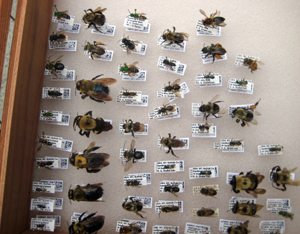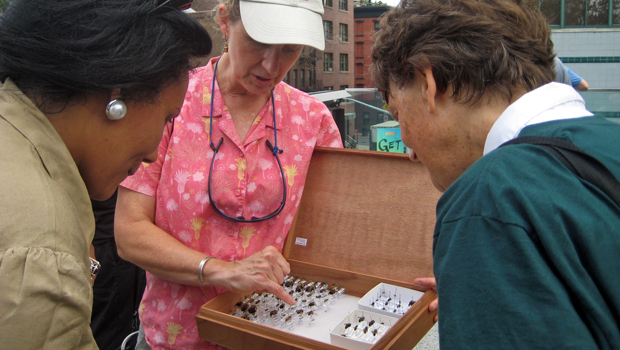The High Line is, as you may already know, the abandoned rail line on Manhattan’s West Side that’s been reinvented as an elevated park. When it was still in service, trains used the High Line to transport milk, meat, produce and other goods. The last train rolled down the line in 1980. But if you listen closely, there’s still cargo being carried.
That buzzing sound you hear these days is Bombus impatiens, the Eastern Bumble Bee, and it’s collecting pollen from some flowering mountain mint that’s been planted here on the High Line. And it’s not alone.
"I didn’t do a full count, but I would guess there are at least a thousand, if not more, individuals foraging here," says Kevin Matteson, an ecologist with Fordham University. "Probably much more."
Matteson is one of the people behind something called The Great Pollinator Project. It’s a collaboration between the American Museum of Natural History and the New York City Parks and Recreation Department's Greenbelt Native Plant Center. The goal is to get members of the public — “citizen scientists” in Great Pollinator parlance — to observe bees and report what they see and where they see it. The project then uses that data to determine how bees are affected by habitat and land use.
"I think what we’re going to find is because insects in general, and bees, are so small, they’re probably able to use a lot smaller habitat patches, little nooks and crannies here to meet their needs," says Elizabeth Johnson, a project scientist who is the manager of the Metropolitan Biodiversity Program at the American Museum of Natural History.
She and Matteson were recently on the High Line to talk about bee conservation, and help the public identify different bees. About 20 bee watchers have shown up to talk about what they’ve seen in the field and ask questions.
"That's a bee?" asks one person.
"Yeah, that's a bee, even the little tiny one," says Johnson.

The task of the bee watcher is straightforward: Choose a single plant to observe, and count the number of bees that land directly on an open flower head. You’re done when you’ve counted five discrete bee visits — or when half an hour passes, whichever comes first. The tricky part is figuring out what type of bee you’re looking at. So Matteson captures a few bees in glass vials to help with the identification process. Luckily for him, he says, "bees don’t hold a grudge."
He opens a vial, and the bee hatches its vertical escape plan. In scientific lingo it's called "negative geotropism," he says, "which is just a way of saying 'they like to fly up.'”
But before it gets away, he identifies it. This particular bee has yellow sides and carries its pollen under its abdomen, so it’s a Leafcutter bee. Not too far away from that bee is a beautiful shiny green metallic bee, and Matteson and the bee watchers spot Wool Carder bees and Long-Horned bees as well. There’s a lot of diversity in the city’s bee population. Since records have been kept, over 200 different species have been recorded here, and Matteson estimates that about 100 are currently flying in the city. Some of those are relative newcomers.
"We have a lot of exotic bee species that have taken up residence and seem to do well in the city," he says. "So, we have about 16 bee species from Europe and Asia originally. They were probably stowaways on ships that came into New York Harbor. And then they’re just established populations here, not just in New York City, but the entire Northeast. But New York City is sort of a hotbed for exotic bees."
This surprises some of the bee watchers. Erenia Meriton works for the Seychelles Embassy. She used to watch carpenter bees in the Seychelles islands, off the coast of Madagascar. Now, she and her two children watch bees on Roosevelt Island. "I was surprised that there were so many bee species here," Meriton says, "not only in New York and America but all over the world. I knew there were a lot of them, but I didn’t know the numbers."
There’s a lot left to learn and Matteson says that when it comes to native bees, we don’t know what we don’t know. "Let’s focus on some of the wild bee species that we don’t know much about, so that we can promote conservation of them and knowledge of them," he says. "Because we don’t want to lose things without even knowing it."
Learn more about The Great Pollinator Project or to sign up to become a bee watcher.
If you need help identifying New York City bees, try this helpful guide.

Elizabeth Johnson, manager of the Metropolitan Biodiversity Program at the American Museum of Natural History, and The Great Pollinator Project
(Photos by Shara Morris)
